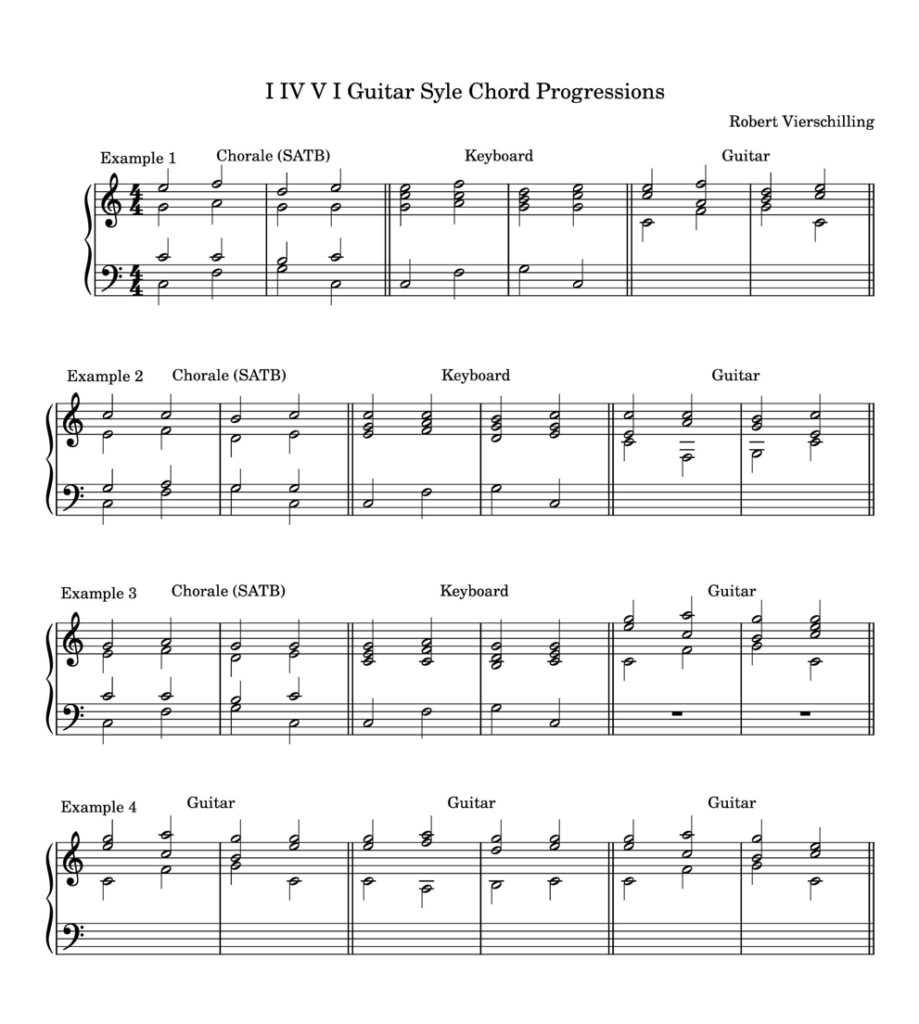In beginning music theory classes, students are usually taught to write their harmony assignments in chorale style (soprano, alto, tenor, bass) and/or keyboard style. In addition, students are encouraged to sing the notes they are writing and play them on the piano keyboard. This is to learn to hear the sounds of the theory they are learning and to have the tactile and visual experience of the sounds on the piano.
Guitarists can add to their experience of understanding and feeling harmony by playing their assignments on the guitar. Assignments need to be modified from chorale style (SATB) to be playable in keyboard style, and even more changes need to be made to have the assignments become playable on guitar. I’ll briefly describe the ways in which I modify theory assignments so that they are playable on guitar.
First, I play assignments in a comfortable register on the guitar, especially in first position whenever possible. Addressing details about the grand staff and the octave transposition by guitar when reading treble clef are beyond the scope of this blog post, though guitarists benefit greatly from understanding the basics of clefs and how they relate to the guitar.
Second, I modify assignments in four-voice choral or keyboard style to three-voice guitar style. Some assignments can be played with all four voices on the guitar, though most cannot (or cannot be played easily). When adapting a four-voice exercise to three voices I always keep the top voice exactly as presented. I keep the bass exactly as presented whenever possible, though I will occasionally make octave adjustments or change pitches in the bass. I rewrite the two middle voices into one voice, making sure I have all the necessary notes to complete the chords. The resulting middle voice is usually not as smooth as the middle voices in chorale or keyboard style.
Third, I bring the two outer voices closer together by an octave. The range of SATB choral style and keyboard style is far wider than the range easily available on guitar.
Fourth, I write and play the assignment on guitar in the same key as choral or keyboard style whenever possible, though I will transpose the exercise to a key that is more playable when necessary.
Below is a page of examples of a I IV V I progression in C major presented three times, each with a different chord tone in the soprano. Each voicing of the progression is presented in chorale, keyboard, and guitar style. Each chord in both chorale style and keyboard style includes all three notes of each chord with the root doubled. Most of the chords in the guitar examples include only the doubled root and the third.
Example 1 begins with the third of the chord in the soprano, and in the guitar style arrangement only the V chord includes all three notes.
In example 2, with the root in the soprano, only the IV chord includes all three notes. I also made an octave adjustment to the bass line for the IV and V chords.
In example 3, with the fifth in the soprano, the I and IV chords include all three notes. However, a three-voice guitar style arrangement of example 3 eludes an elegant solution. The solution I present in example three includes a fourth note in the final chord.
Example 4 presents three additional guitar style solutions for example 3, each with its own shortcomings. The first solution in example 4 has the leading tone in the middle voice leaping up a fourth rather than resolving up by half step. The second solution in example 4 alters the original bass line, while the third solution in example 4 alters the top voice. An unacceptable solution would be to double the root and include the fifth instead of the third.
Most importantly, remember that the goal is to learn to better hear and understand harmony, and not just write the correct notes on a piece of paper or place the fingers in the correct place on the piano or guitar.

Click the button below to download a copy of Guitar Style Chord Progressions
